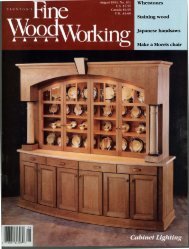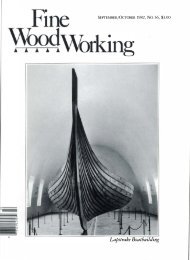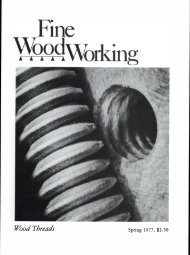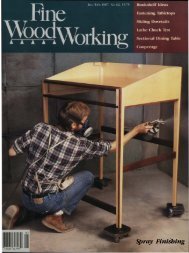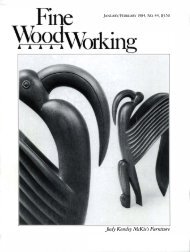NOVEMBER/DECEMBER 1983, No. 43, $3.50 Making ... - Wood Tools
NOVEMBER/DECEMBER 1983, No. 43, $3.50 Making ... - Wood Tools
NOVEMBER/DECEMBER 1983, No. 43, $3.50 Making ... - Wood Tools
Create successful ePaper yourself
Turn your PDF publications into a flip-book with our unique Google optimized e-Paper software.
British woodworking at The Studio in Miami. Even in the more colorful examples, the legacy of the Arts and Crafts movement is<br />
strong: bold rectilinearity and straightforward construction.<br />
British Enter Miami<br />
New gallery imports current work from Europe<br />
by Rick Mastelli<br />
Americans haven't had much opportunity to see contempo<br />
Il.. rary European woodwork. Museums may be full of venerable<br />
English and French period furniture, but the only exposure<br />
most of us have had to what's being done lately across<br />
the Atlantic is through photographs. With the opening last<br />
spring of Charles Nesbit's Studio in Miami, Fla., a gallery<br />
devoted to work by British and eventually also by other European<br />
craftspeople, winter vacation plans can include a firsthand<br />
look at what the Old World is up to. Nesbit has just<br />
moved into a 2500-sq.-ft. space in the Decorative ArtS Plaza<br />
in Miami's thriving design distria. On display when I visited<br />
last April were some 35 pieces by 17 of the better-known<br />
woodworkers in England.<br />
The vitality of the designs and the quality of the craftsmanship<br />
were at least equal to that of most gallety-displayed<br />
woodwork in this country. Many of the themes-color in<br />
wood and Post-Modernist whimsy-have become familiar to<br />
us as avant-garde. But here these practices took on sober respectability.<br />
They seemed not fads, but the most recent<br />
installments in an eminent tradition. Anchored by the straight-<br />
forward, rectilinear precedents of the Arts and Crafts movement,<br />
the British seem to come to design by way of craftsmanship,<br />
rather than the opposite tendency here in America.<br />
Nesbit, a British-educated economist who retired from<br />
his own consttuction company to pursue full-time his avocation<br />
of collecting art and craft, describes the situation this<br />
way: "British craftspeople work no differently today than they<br />
ever have. They have the same modest workshops and serve<br />
the same class of patrons. Time is probably of less concern to<br />
British woodworkers than it is to Americans. Quality work is<br />
less extraordinary."<br />
See what you think from the photos on the following three<br />
pages, but if you get to Miami, don't miss the real things.<br />
Nesbit's studio (at 400 1 NE 2nd Ave.) is open weekdays,<br />
and in the spring he plans the first of what he hopes will be<br />
an annual event-a super-show of 100 pieces of furniture, all<br />
from Europe. The Events column in a future issue of FWW<br />
will list the dates. (continued on next page)<br />
Rick Mastelli is an associate editor of Fine <strong>Wood</strong>working.<br />
73



